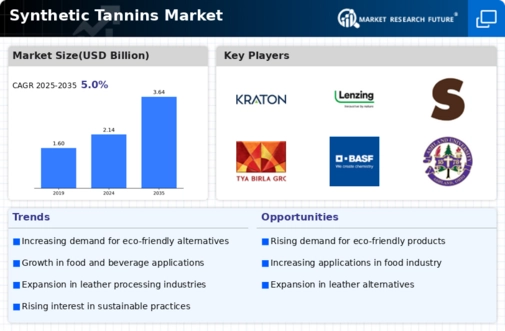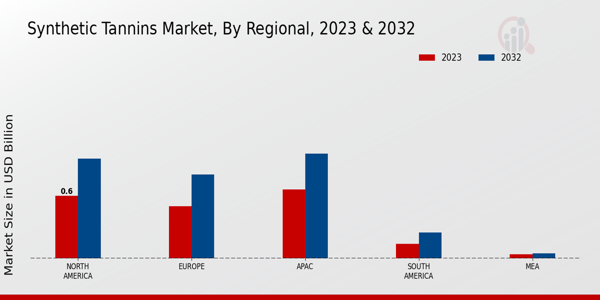Market Growth Projections
The Global Synthetic Tannins Market Industry is projected to experience substantial growth, with estimates indicating a rise from 2.14 USD Billion in 2024 to 3.64 USD Billion by 2035. This growth trajectory reflects an increasing adoption of synthetic tannins across various sectors, driven by their versatility and sustainability. The anticipated CAGR of 4.96% from 2025 to 2035 suggests a steady expansion, as industries recognize the benefits of synthetic tannins in enhancing product quality and meeting consumer demands for eco-friendly solutions. This upward trend underscores the market's potential and the evolving landscape of synthetic tannin applications.
Rising Demand in Leather Industry
The Global Synthetic Tannins Market Industry experiences a notable surge in demand driven by the leather sector. Synthetic tannins are increasingly favored for their eco-friendly properties and consistent quality. In 2024, the market is projected to reach 2.14 USD Billion, reflecting the industry's shift towards sustainable practices. This trend is particularly evident in regions where environmental regulations are stringent, prompting manufacturers to seek alternatives to traditional tanning agents. As the leather industry continues to expand, particularly in Asia-Pacific, the demand for synthetic tannins is expected to grow, further solidifying their role in the market.
Growth in Food and Beverage Sector
The Global Synthetic Tannins Market Industry benefits from the expanding food and beverage sector, where synthetic tannins are utilized as natural preservatives and flavor enhancers. Their application in wine production, for instance, is significant, as they contribute to the astringency and mouthfeel of wines. This sector's growth is projected to drive the market value to 3.64 USD Billion by 2035. The increasing consumer preference for natural ingredients and clean-label products is likely to bolster the demand for synthetic tannins, as manufacturers seek to meet these evolving consumer expectations while ensuring product stability and quality.
Advancements in Chemical Technology
Technological advancements in the production of synthetic tannins are transforming the Global Synthetic Tannins Market Industry. Innovations in chemical processes enhance the efficiency and reduce the environmental impact of synthetic tannin production. These advancements may lead to cost reductions and improved product quality, making synthetic tannins more appealing to various industries, including textiles and cosmetics. As a result, the market is poised for growth, with a projected CAGR of 4.96% from 2025 to 2035. The ability to produce tailored synthetic tannins for specific applications could further expand their market reach and applications.
Regulatory Support for Eco-Friendly Products
The Global Synthetic Tannins Market Industry is positively influenced by regulatory frameworks that promote the use of eco-friendly products. Governments worldwide are implementing policies that encourage the adoption of sustainable materials in various industries, including leather, food, and textiles. This regulatory support not only enhances the market's credibility but also incentivizes manufacturers to invest in synthetic tannins as viable alternatives to traditional tanning agents. As these regulations become more stringent, the demand for synthetic tannins is expected to rise, positioning the market for robust growth in the coming years.
Increasing Awareness of Sustainable Practices
The Global Synthetic Tannins Market Industry is witnessing a shift towards sustainability, as consumers and manufacturers alike become more aware of environmental impacts. This awareness drives the demand for synthetic tannins, which are often derived from renewable resources and have a lower ecological footprint compared to traditional tannins. Companies are increasingly adopting sustainable practices, aligning their production processes with global sustainability goals. This trend is likely to enhance the market's growth trajectory, as stakeholders prioritize eco-friendly solutions in their operations, thereby fostering a more sustainable future for the synthetic tannins industry.










